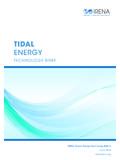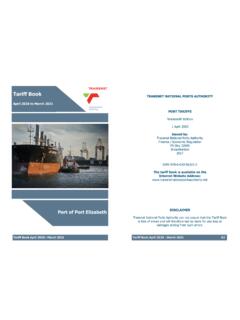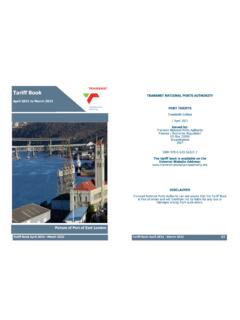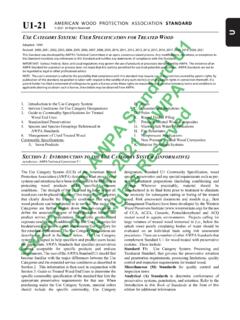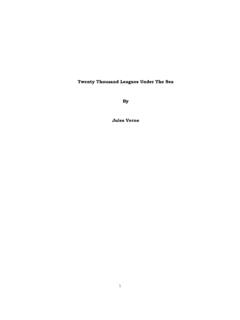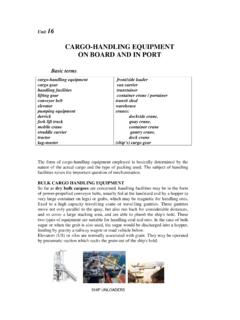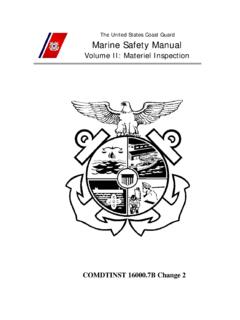Transcription of Floating Foundations: A Game Changer for Offshore Wind …
1 Offshore WIND1 Some of the largest potential markets, such as Japan and the United States, possess few shallow-water sites suitable for Offshore wind development. Floating foundations could be game changers in this regard. Floating foundations offer the Offshore wind industry two decisive opportunities: They allow access to deep-water sites. In water deeper than 50 metres, they offer access to large areas with a strong wind resource and proximity to population centres. For some countries, such as those with a narrow continental shelf, Floating foundations offer the only opportunity for large-scale Offshore wind deployment.
2 They ease turbine set-up. In mid-depth conditions (30-50 metres), they may in time offer a lower-cost alternative to fixed-bottom foundations , given the potential for standardisation of foundation designs and the use of low-cost, readily available installation addition, Floating foundations generally offer environmental benefits compared with fixed-bottom designs due to less-invasive activity on the seabed during foundations : A GAME Changer FOR Offshore WIND POWER Today s Offshore wind turbines, rooted to the seabed by monopile or jacket foundations , are restricted to waters less than 50 metres deep.
3 This rules out sites with the strongest winds and, often, access to big markets. Floating foundations , by eliminating the depth constraint and easing turbine set-up, could open the way for power generation from deeper waters. Motivation to develop Floating foundationsA SUPPLEMENT TO INNOVATION OUTLOOK: Offshore WIND (IRENA, 2016)INNOVATION OUTLOOK: 2 Figure 1: Offshore wind Floating foundation conceptsIllustration by Joshua Bauer, National Renewable Energy Laboratory (US Department of Energy) Floating foundations are already proven in harsh operating environments.
4 The main concepts for Offshore wind power are well known in the oil and gas sector, where they are deployed commercially at a large scale. Platform designs for Offshore wind, however, require adaptation to accommodate different dynamic characteristics and a distinct loading pattern. The same process has already occurred to a great extent for fixed-bottom foundations , including monopiles, jackets and gravity-base of Floating wind farms is anticipated between 2020 and 2025. The first full-scale prototypes for Floating wind turbines have been in operation for several years.
5 Demonstration continues for new Floating foundation concepts. The first Floating wind farm, with 30 megawatts (MW) of power generation capacity at more than 100 metres (m) water depth, is scheduled to start operating off the coast of Scotland by the end of 2017. By 2020, based on progress seen in the market, three to five additional foundation designs should have been demonstrated at full scale (2 MW or larger).The three main concepts for Floating foundations are spar-buoy, semi-submersible and tension leg platform, as illustrated in figure 1.
6 Variants on these also exist, including the mounting of multiple turbines onto a single Floating 1 describes each of the three concepts, including their pros and cons and the status of first movers, fast followers and others developing the status of Floating foundationsOFFSHORE WIND3 Commercialising and deploying new technology in the energy sector is always a big challenge. It involves a conservative business sector, requires large quantities of capital, takes considerable time and affects a broad range of stakeholders.
7 In some cases, it requires cultural change. While many of the technical principles of Floating Offshore wind have been demonstrated, barriers to large-scale deployment remain. Floating Offshore wind technology, even more than its fixed-bottom counterpart, faces two major, and inter-related, challenges: The magnitude of the commercial challenge, in terms of being investable and finding investors; A mismatch between innovation horsepower and corporate staying to deploymentDeployment and cost-of-energy goalsTo contribute significantly to the global energy mix in the coming decades, Floating Offshore wind systems need to become less costly and, in turn, to be widely market uptake is too slow, then the supply chain will not materialise, and costs will not come down rapidly enough for Floating Offshore wind to keep up with cost-of-energy reductions anticipated in other technologies.
8 As with any technology, there is strong interaction between market volume and cost. Being investable and finding an investorAbout 20 players are already involved in moving Floating foundation technologies from the early-concept stage through to commercial deployment. This maturation is likely to require another 15 years, and there are no existing markets to tap for commercial-scale Floating Offshore wind any given player, today s pre-commercial projects (single demonstrator, 5- to 10-turbine pilot, then first utility-scale project of 200 MW-plus) could require a total investment (in excess of market-rate project revenues) of hundreds of millions of dollars over the lifetime of the projects.
9 Even the operating costs for the Floating foundation technology company itself (staff and third-party costs to develop and take the technology to market) are tens of millions of dollars over a 10- to 15-year period. The time needed to attain profitability is long, and the sums of money required are large, considering the uncertainty in the eventual market. Market potential depends on the relative advancement of Offshore wind compared to other forms of electricity generation and on addressing specific technical risks related to Floating Offshore wind.
10 As a result, the financial profile of a Floating foundation technology company does not match the needs of most private a few cases, private investors are bearing the technology company's operating costs and a small portion of above-market pre-commercial project costs. Similarly, the French, Japanese and Scottish governments, along with the European Commission, are stepping forward with project-support mechanisms. At present, however, there is no clear path for the leading technologies to gain enough support to reach utility-scale commercial deployment.






